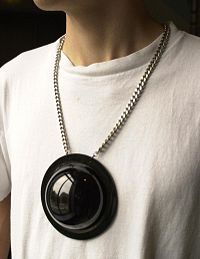Sousveillance

Sousveillance [ suveˈjɑ̃s ] ( French for " surveillance ") describes the reversal of the usual surveillance path . While state or otherwise privileged institutions normally monitor people without special rights, in Sousveillance it is the monitored who monitor higher-ranking institutions.
The concept and term were coined by the American professor Steve Mann as “ watchful vigilance from underneath ” (English “attentive vigilance from below”). Mann conducts research in the fields of wearable computing and augmented reality and has developed technical aids with devices such as the EyeTap , with which ordinary people can easily record images of their surroundings.
He formed the concept of sousveillance as a criticism of political advances in the direction of the surveillance state . Man, who feels himself to be the first human cyborg and regards his technical aids as body parts, has repeatedly demonstrated in the past to users of surveillance cameras how uncomfortable it feels when all of his own actions are recorded by others.
The ubiquitous cameras in buildings and in public places ( CCTV ) as a form of surveillance can be contrasted with “surveillance” by means of ubiquitous mobile cameras in smartphones, on sports helmets or in vehicles ( dashcam ).
See also
Web links
- Steve Mann: Digital eye glasses like Google's Project Glass, and my earlier Digital Eye Glass, will transform society because they introduce a two-sided surveillance and sousveillance. Here is some history and my future predictions. - Opinion in Time from November 2, 2012
- Jascha Hoffman: Sousveillance - NYT Magazine, December 10, 2006 ("... 1991, when footage from a home video camera exposed the Los Angeles police officers who beat Rodney King ")